Chongxuan Li
LLaDA2.0: Scaling Up Diffusion Language Models to 100B
Dec 24, 2025Abstract:This paper presents LLaDA2.0 -- a tuple of discrete diffusion large language models (dLLM) scaling up to 100B total parameters through systematic conversion from auto-regressive (AR) models -- establishing a new paradigm for frontier-scale deployment. Instead of costly training from scratch, LLaDA2.0 upholds knowledge inheritance, progressive adaption and efficiency-aware design principle, and seamless converts a pre-trained AR model into dLLM with a novel 3-phase block-level WSD based training scheme: progressive increasing block-size in block diffusion (warm-up), large-scale full-sequence diffusion (stable) and reverting back to compact-size block diffusion (decay). Along with post-training alignment with SFT and DPO, we obtain LLaDA2.0-mini (16B) and LLaDA2.0-flash (100B), two instruction-tuned Mixture-of-Experts (MoE) variants optimized for practical deployment. By preserving the advantages of parallel decoding, these models deliver superior performance and efficiency at the frontier scale. Both models were open-sourced.
ReFusion: A Diffusion Large Language Model with Parallel Autoregressive Decoding
Dec 15, 2025Abstract:Autoregressive models (ARMs) are hindered by slow sequential inference. While masked diffusion models (MDMs) offer a parallel alternative, they suffer from critical drawbacks: high computational overhead from precluding Key-Value (KV) caching, and incoherent generation arising from learning dependencies over an intractable space of token combinations. To address these limitations, we introduce ReFusion, a novel masked diffusion model that achieves superior performance and efficiency by elevating parallel decoding from the token level to a higher slot level, where each slot is a fixed-length, contiguous sub-sequence. This is achieved through an iterative ``plan-and-infill'' decoding process: a diffusion-based planning step first identifies a set of weakly dependent slots, and an autoregressive infilling step then decodes these selected slots in parallel. The slot-based design simultaneously unlocks full KV cache reuse with a unified causal framework and reduces the learning complexity from the token combination space to a manageable slot-level permutation space. Extensive experiments on seven diverse benchmarks show that ReFusion not only overwhelmingly surpasses prior MDMs with 34% performance gains and an over 18$\times$ speedup on average, but also bridges the performance gap to strong ARMs while maintaining a 2.33$\times$ average speedup.
Saying the Unsaid: Revealing the Hidden Language of Multimodal Systems Through Telephone Games
Nov 12, 2025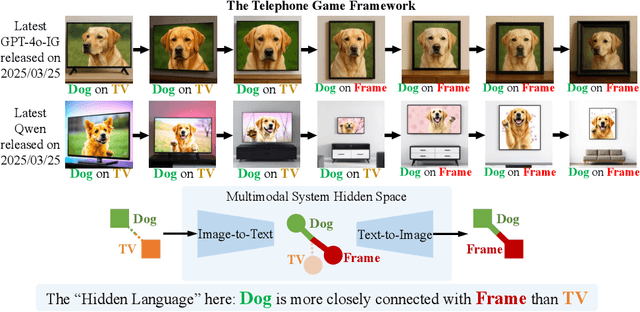
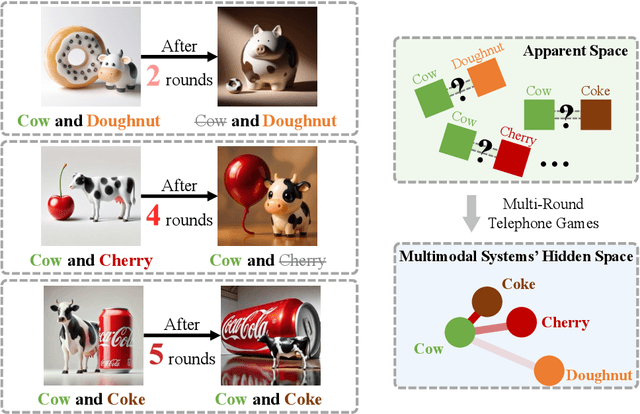


Abstract:Recent closed-source multimodal systems have made great advances, but their hidden language for understanding the world remains opaque because of their black-box architectures. In this paper, we use the systems' preference bias to study their hidden language: During the process of compressing the input images (typically containing multiple concepts) into texts and then reconstructing them into images, the systems' inherent preference bias introduces specific shifts in the outputs, disrupting the original input concept co-occurrence. We employ the multi-round "telephone game" to strategically leverage this bias. By observing the co-occurrence frequencies of concepts in telephone games, we quantitatively investigate the concept connection strength in the understanding of multimodal systems, i.e., "hidden language." We also contribute Telescope, a dataset of 10,000+ concept pairs, as the database of our telephone game framework. Our telephone game is test-time scalable: By iteratively running telephone games, we can construct a global map of concept connections in multimodal systems' understanding. Here we can identify preference bias inherited from training, assess generalization capability advancement, and discover more stable pathways for fragile concept connections. Furthermore, we use Reasoning-LLMs to uncover unexpected concept relationships that transcend textual and visual similarities, inferring how multimodal systems understand and simulate the world. This study offers a new perspective on the hidden language of multimodal systems and lays the foundation for future research on the interpretability and controllability of multimodal systems.
LLaDA-Rec: Discrete Diffusion for Parallel Semantic ID Generation in Generative Recommendation
Nov 09, 2025Abstract:Generative recommendation represents each item as a semantic ID, i.e., a sequence of discrete tokens, and generates the next item through autoregressive decoding. While effective, existing autoregressive models face two intrinsic limitations: (1) unidirectional constraints, where causal attention restricts each token to attend only to its predecessors, hindering global semantic modeling; and (2) error accumulation, where the fixed left-to-right generation order causes prediction errors in early tokens to propagate to the predictions of subsequent token. To address these issues, we propose LLaDA-Rec, a discrete diffusion framework that reformulates recommendation as parallel semantic ID generation. By combining bidirectional attention with the adaptive generation order, the approach models inter-item and intra-item dependencies more effectively and alleviates error accumulation. Specifically, our approach comprises three key designs: (1) a parallel tokenization scheme that produces semantic IDs for bidirectional modeling, addressing the mismatch between residual quantization and bidirectional architectures; (2) two masking mechanisms at the user-history and next-item levels to capture both inter-item sequential dependencies and intra-item semantic relationships; and (3) an adapted beam search strategy for adaptive-order discrete diffusion decoding, resolving the incompatibility of standard beam search with diffusion-based generation. Experiments on three real-world datasets show that LLaDA-Rec consistently outperforms both ID-based and state-of-the-art generative recommenders, establishing discrete diffusion as a new paradigm for generative recommendation.
Variational Reasoning for Language Models
Sep 26, 2025



Abstract:We introduce a variational reasoning framework for language models that treats thinking traces as latent variables and optimizes them through variational inference. Starting from the evidence lower bound (ELBO), we extend it to a multi-trace objective for tighter bounds and propose a forward-KL formulation that stabilizes the training of the variational posterior. We further show that rejection sampling finetuning and binary-reward RL, including GRPO, can be interpreted as local forward-KL objectives, where an implicit weighting by model accuracy naturally arises from the derivation and reveals a previously unnoticed bias toward easier questions. We empirically validate our method on the Qwen 2.5 and Qwen 3 model families across a wide range of reasoning tasks. Overall, our work provides a principled probabilistic perspective that unifies variational inference with RL-style methods and yields stable objectives for improving the reasoning ability of language models. Our code is available at https://github.com/sail-sg/variational-reasoning.
Masked Diffusion Models as Energy Minimization
Sep 17, 2025
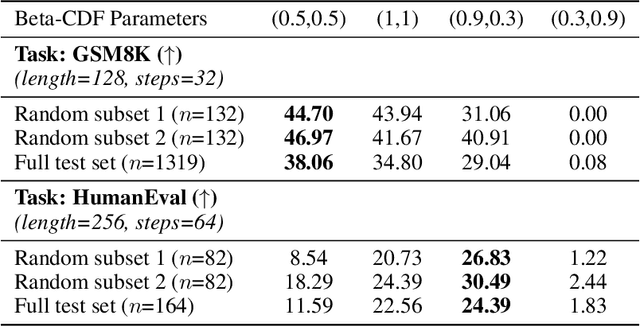
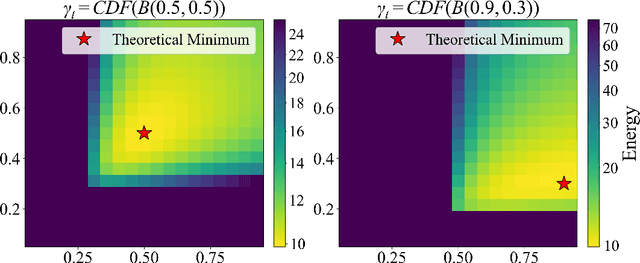

Abstract:We present a systematic theoretical framework that interprets masked diffusion models (MDMs) as solutions to energy minimization problems in discrete optimal transport. Specifically, we prove that three distinct energy formulations--kinetic, conditional kinetic, and geodesic energy--are mathematically equivalent under the structure of MDMs, and that MDMs minimize all three when the mask schedule satisfies a closed-form optimality condition. This unification not only clarifies the theoretical foundations of MDMs, but also motivates practical improvements in sampling. By parameterizing interpolation schedules via Beta distributions, we reduce the schedule design space to a tractable 2D search, enabling efficient post-training tuning without model modification. Experiments on synthetic and real-world benchmarks demonstrate that our energy-inspired schedules outperform hand-crafted baselines, particularly in low-step sampling settings.
A Survey on Latent Reasoning
Jul 08, 2025


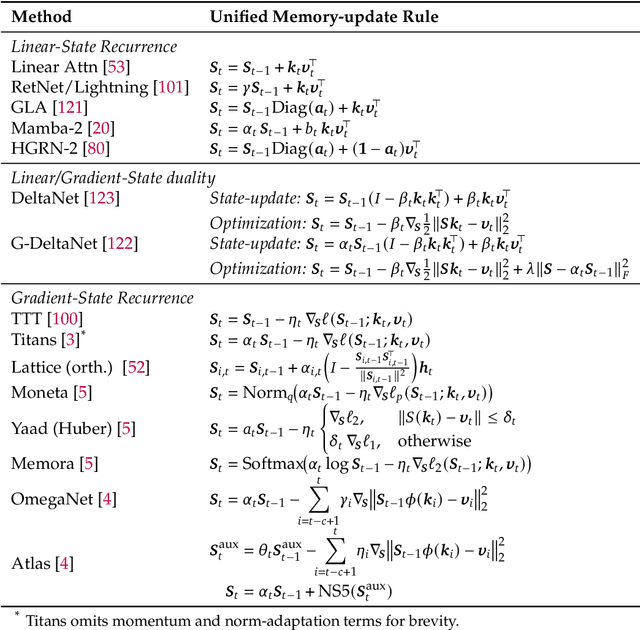
Abstract:Large Language Models (LLMs) have demonstrated impressive reasoning capabilities, especially when guided by explicit chain-of-thought (CoT) reasoning that verbalizes intermediate steps. While CoT improves both interpretability and accuracy, its dependence on natural language reasoning limits the model's expressive bandwidth. Latent reasoning tackles this bottleneck by performing multi-step inference entirely in the model's continuous hidden state, eliminating token-level supervision. To advance latent reasoning research, this survey provides a comprehensive overview of the emerging field of latent reasoning. We begin by examining the foundational role of neural network layers as the computational substrate for reasoning, highlighting how hierarchical representations support complex transformations. Next, we explore diverse latent reasoning methodologies, including activation-based recurrence, hidden state propagation, and fine-tuning strategies that compress or internalize explicit reasoning traces. Finally, we discuss advanced paradigms such as infinite-depth latent reasoning via masked diffusion models, which enable globally consistent and reversible reasoning processes. By unifying these perspectives, we aim to clarify the conceptual landscape of latent reasoning and chart future directions for research at the frontier of LLM cognition. An associated GitHub repository collecting the latest papers and repos is available at: https://github.com/multimodal-art-projection/LatentCoT-Horizon/.
Reinforcing General Reasoning without Verifiers
May 27, 2025Abstract:The recent paradigm shift towards training large language models (LLMs) using DeepSeek-R1-Zero-style reinforcement learning (RL) on verifiable rewards has led to impressive advancements in code and mathematical reasoning. However, this methodology is limited to tasks where rule-based answer verification is possible and does not naturally extend to real-world domains such as chemistry, healthcare, engineering, law, biology, business, and economics. Current practical workarounds use an additional LLM as a model-based verifier; however, this introduces issues such as reliance on a strong verifier LLM, susceptibility to reward hacking, and the practical burden of maintaining the verifier model in memory during training. To address this and extend DeepSeek-R1-Zero-style training to general reasoning domains, we propose a verifier-free method (VeriFree) that bypasses answer verification and instead uses RL to directly maximize the probability of generating the reference answer. We compare VeriFree with verifier-based methods and demonstrate that, in addition to its significant practical benefits and reduced compute requirements, VeriFree matches and even surpasses verifier-based methods on extensive evaluations across MMLU-Pro, GPQA, SuperGPQA, and math-related benchmarks. Moreover, we provide insights into this method from multiple perspectives: as an elegant integration of training both the policy and implicit verifier in a unified model, and as a variational optimization approach. Code is available at https://github.com/sail-sg/VeriFree.
LLaDA 1.5: Variance-Reduced Preference Optimization for Large Language Diffusion Models
May 25, 2025
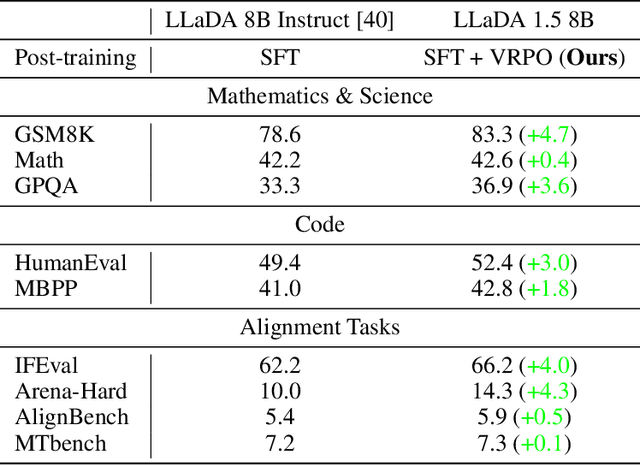
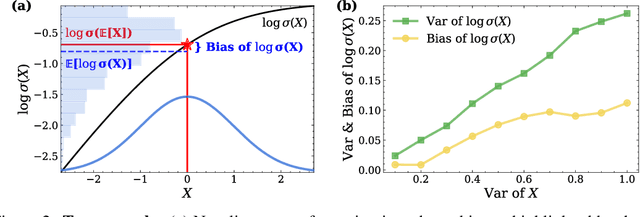
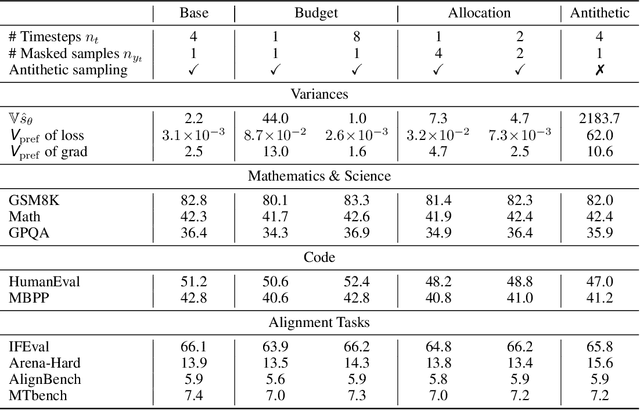
Abstract:While Masked Diffusion Models (MDMs), such as LLaDA, present a promising paradigm for language modeling, there has been relatively little effort in aligning these models with human preferences via reinforcement learning. The challenge primarily arises from the high variance in Evidence Lower Bound (ELBO)-based likelihood estimates required for preference optimization. To address this issue, we propose Variance-Reduced Preference Optimization (VRPO), a framework that formally analyzes the variance of ELBO estimators and derives bounds on both the bias and variance of preference optimization gradients. Building on this theoretical foundation, we introduce unbiased variance reduction strategies, including optimal Monte Carlo budget allocation and antithetic sampling, that significantly improve the performance of MDM alignment. We demonstrate the effectiveness of VRPO by applying it to LLaDA, and the resulting model, LLaDA 1.5, outperforms its SFT-only predecessor consistently and significantly across mathematical (GSM8K +4.7), code (HumanEval +3.0, MBPP +1.8), and alignment benchmarks (IFEval +4.0, Arena-Hard +4.3). Furthermore, LLaDA 1.5 demonstrates a highly competitive mathematical performance compared to strong language MDMs and ARMs. Project page: https://ml-gsai.github.io/LLaDA-1.5-Demo/.
LLaDA-V: Large Language Diffusion Models with Visual Instruction Tuning
May 22, 2025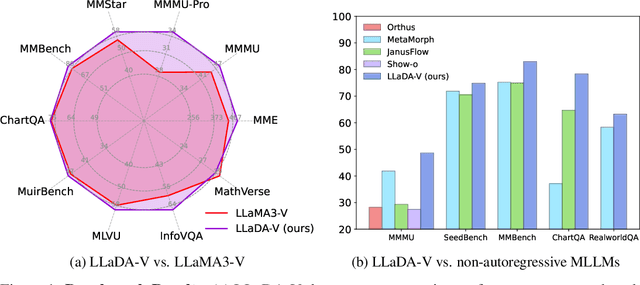
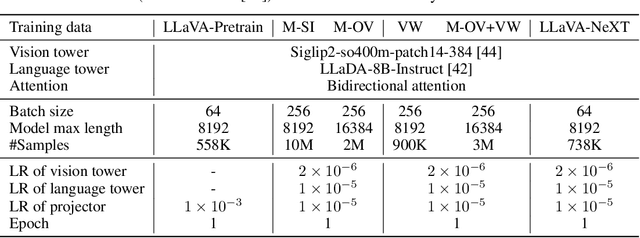
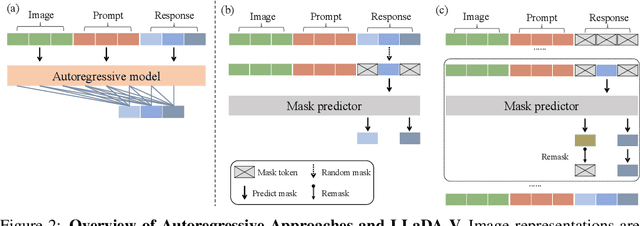
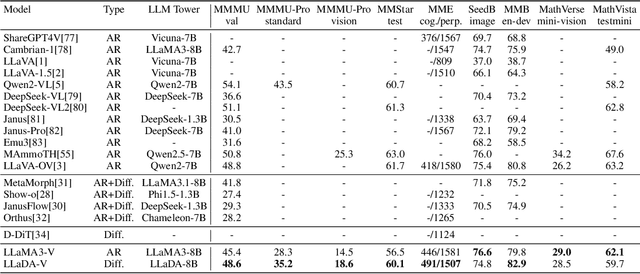
Abstract:In this work, we introduce LLaDA-V, a purely diffusion-based Multimodal Large Language Model (MLLM) that integrates visual instruction tuning with masked diffusion models, representing a departure from the autoregressive paradigms dominant in current multimodal approaches. Built upon LLaDA, a representative large language diffusion model, LLaDA-V incorporates a vision encoder and MLP connector that projects visual features into the language embedding space, enabling effective multimodal alignment. Our empirical investigation reveals several intriguing results: First, LLaDA-V demonstrates promising multimodal performance despite its language model being weaker on purely textual tasks than counterparts like LLaMA3-8B and Qwen2-7B. When trained on the same instruction data, LLaDA-V is highly competitive to LLaMA3-V across multimodal tasks with better data scalability. It also narrows the performance gap to Qwen2-VL, suggesting the effectiveness of its architecture for multimodal tasks. Second, LLaDA-V achieves state-of-the-art performance in multimodal understanding compared to existing hybrid autoregressive-diffusion and purely diffusion-based MLLMs. Our findings suggest that large language diffusion models show promise in multimodal contexts and warrant further investigation in future research. Project page and codes: https://ml-gsai.github.io/LLaDA-V-demo/.
 Add to Chrome
Add to Chrome Add to Firefox
Add to Firefox Add to Edge
Add to Edge